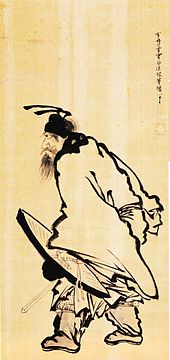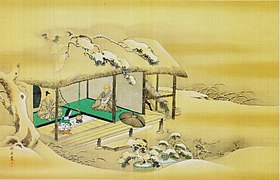Bälz Collection
The Bälz Collection is an important collection of Japanese painting from the 18th and 19th centuries that the doctor Erwin Bälz brought to Germany from his long stay in Japan during the Meiji period . The collection is in the Linden Museum in Stuttgart.
Overview
In Japan, Bälz was not only an internist, anthropologist and personal physician to the imperial family, he was also interested in Japanese art and started a collection. This collection of around 6,000 objects came to the museum in 1883 and 1893, initially as a loan, today as a property. On the occasion of an exhibition of a selection of pictures and objects, a catalog was published - created with great support from the Japanese side in terms of identifying the artists and describing the works. The catalog shows images by almost a hundred artists and thus indicates the content of the collection.
The structure of the catalog follows the Far Eastern scheme: flower motifs ( 花 , Hana ), ink painting ( 墨 画 , Bokuga ), bird motifs ( 鳥 , Tori ), seasons ( 和 の 四季 , Wa no shiki ), pictures in the Chinese style ( 漢画 系 , Kangakei ), genre pictures ( 風俗 , Fūzoku ), humor ( ユ ー モ ア , Yūmoa ), animal motifs ( 動物 , Dōbutsu ), prints and applied arts ( 摺 物 ・ 工 芸 美術 , surimono - Kōgei bijtsu ).
List of artists
The life dates could not be clarified for all artists.
- Akinobu ( 章 信 ; active 19th century, Kanō school )
- Amano Shōko ( 天野 松 湖 ; Meiji period)
- Araki Kampo ( 荒木 寛 畝 ; 1831–1915)
- Chō Shūkoku ( 長 秋谷 )
- Eno Baisetsu Hidenobu ( 江 野 楳 雪 英 信 ; active 2nd half of 19th century, Kanō school )
- Fujiwara Korenobu ( 藤原 惟 信 )
- Gan Ryō ( 岸 良 ; 1798-1852)
- Giryō ( 義 亮 )
- Hanabusa Itchō ( 英 一 蝶 ; 1652-1724)
- Hara Zaimei ( 原 在 明 ; 1778–1844)
- Haruki Nammei ( 春 木 南 溟 )
- Haruki Seiko ( 春 木 西湖 ;? –1853)
- Hasegawa Sekkō ( 長谷川 雪 光 )
- Hasegawa Sesshin ( 長谷川 雪 真 )
- Hasegawa Settan ( 長谷川 雪 旦 ; 1778–1843)
- Hashimoto Gahō ( 橋本 雅邦 ; 1835–1908)
- Hemmi Kazunobu ( 逸 見 一 信 )
- Higuchi Tangetsu ( 樋 口 探 月 ; 1821–1896)
- Hirasawa Byōsan ( 平 沢 屏山 ; 1822–1876)
- Ikawa Kunjaku ( 井 川 君 鍚 )
- Itaya Keishū Hironobu ( 板 谷 桂舟弘 延 )
- Itaya Keishū Hirotaka ( 板 谷 桂 舟 広 隆 ; 1786–1831)
- Kaneko Kinryō ( 金子 金陵 ;? –1817)
- Kanō Eisen'in Michinobu ( 狩 野 栄 川 院 典 信 ; 1730–1790)
- Kanō Isen'in Naganobu ( 狩 野 伊川 院 栄 信 ; 1775–1828)
- Kanō Keiun Hisanobu ( 狩 野 ? 運 久 信 )
- Kanō Seisen'in Osanobu ( 狩 野 晴川 院 養 信 )
- Kanō Shosen'in Masanobu ( 狩 野 勝 川 院 雅 信 ; 1823–1880)
- Kanō Tanshin Morimichi ( 狩 野 探 信守 道 ; 1785–1836)
- Kanō Tōju Katsunobu ( 狩 野 洞 壽 克 信 ;? –1777)
- Kanō Tōshun Hidenobu ( 狩 野 洞 春秀 信 ;? –1884)
- Kanō Tōshun Yoshinobu ( 狩 野 洞 春 美 信 )
- Kataoka Unkaku ( 片 岡 雲鶴 )
- Katayama Kyōkō ( 片 山 九皐 )
- Kawanabe Kyōsai ( 河 鍋 暁 斎 ; 1831–1889)
- Kishi Renzan ( 岸 連山 ; 1805-1856)
- Kō Sūkoku II ( 高嵩 谷 二世 ; 1798–1875)
- Kobayashi Eitaku ( 小 林永 濯 ; 1843–1890)
- Kōgetsu Moriyoshi ( 鈎 月 守 能 )
- Kōhō ( 広 峰 ; active 19th century; Kanō school )
- Kokumei ( 克明 )
- Makino Seikan ( 牧野 成 貫 )
- Megata Unsen ( 目 賀 多雲 川 ;? –1714)
- Miki Kōzan ( 三 木 恒山 ; 1807-1891)
- Miwa Zaiei ( 三輪 在 栄 ;? –1789)
- Mochizuki Gyokusen ( 望月 玉泉 ; 1834–1913)
- Nakamura Banzan ( 中 村 晩 山 ; 19th century)
- Nakamura Ransen ( 中 村 藍 川 ; active 1st half of the 19th century)
- Narutomi Chin'oku ( 成 富 椿 屋 ; active 1st half of the 19th century)
- Nishimura Hideaki ( 西村 昆明 )
- Oda Kyōshō ( 織田 共 樵 ; 19th century)
- Ogata Tōshō ( 尾形 洞 霄 ; 19th century)
- Oguri Kanrei ( 小 栗 寛 令 ;? –1830/42)
- Ōhara Bunrin ( 大 原文 林 ; 1801–1892)
- Oki Ichiga ( 沖 一 峨 ; 1797–1855)
- Oki Kangaku ( 沖 冠 岳 ;? –1876)
- Ōnishi Chinnen ( 大西 椿 年 ; 1792–1851)
- Ōnishi Keisai ( 大西 圭 斎 ; 1773–1829)
- Ōyagi Yakō ( 大 八 木 也 香 ;? –1874)
- Ryūseki ( 流 石 ; active 19th century)
- Sangaku ( 讃 岳 ; active 18th / 19th century)
- Satake Eison ( 佐 竹 永 邨 ; 1845–1922)
- Seiryū ( 青 陵 ; active 19th century)
- Shiba Rinsai ( 芝 琳 斎 ; active 1869 to 1890)
- Shibata Zeshin ( 柴 田 是 真 ; 1807-1891)
- Shimada Gentan ( 島 田 元旦 ; 1778–1840)
- Shimizu Temmin ( 清水 天 民 ; mid Edo period)
- Shiokawa Bunrin ( 塩 川 文麟 ; 1808–1877)
- Shirahase Bunkō ( 白 波 瀬 汶 江 ; active 1st half of the 19th century)
- Shirai Kayō ( 白井華 陽 ; died 1836)
- Shūgan ( 秋 嵓 )
- Shūhō ( 秀峰 ; active 1st half of the 19th century)
- Shunkōsai Hokushū ( 春 好 斎 北 洲 ; active mid 19th century)
- Shunsai ( 儁 斎 ; active 19th century)
- Sō Shikō ( 宋 紫 岡 ; 1781–1850)
- Soin ( 鼠 隠 )
- Suzuki Fuyō ( 鈴木 芙蓉 ; 1752–1816)
- Takahashi Shōun ( 高橋 湘雲 )
- Takebe Sōchō ( 建 部 巣 兆 ;? –1816)
- Tani Bunchō ( 谷 文 晁 ; 1763–1841)
- Taniguchi Gessō ( 谷口 月 窓 ; 1774–1865)
- Tōdō Takasawa ( 藤 堂 高 兌 ; 1781–1825)
- Uchida Tōkyū ( 内 田 陶 丘 ;? –1808)
- Unkoku Tōban ( 雲 谷 等 璠 ; 1635–1724)
- Utagawa Hiroshige II ( 歌 川 広 重 二世 ; 1826–1869)
- Yamanouchi Yōshun Korenaga ( 山 内 養 春 惟 長 )
- Yasuda Beisai ( 安 田 米 斎 ; 1848–1888)
- Yokoyama Kazan ( 横山 華山 ; 1781–1837)
- Yoshizawa Setsuan ( 吉 沢 雪 葊 ;? –1889)
photos
Suzuki Fuyō: Fuji at Dawn, 1795
Kanō Morimichi: Eight Views of Lake Biwa
Kanō Michinobu: The poet Su Shi rides through the snow
Oki Ichiga: Scene from a Nō drama
Remarks
- ↑ Shōki ( 鍾 馗 ) was a legendary demon slayer.
- ↑ Not in the catalog quoted here.
- ↑ Wine grapes in the style of Wen Riguan ( 倣 日 観 ; died around 1295).
Individual evidence
- ↑ It's a scene from Hacbi-no-ki ( 鉢 木 ), which takes place in winter. (Hermann Bohner: The individual Nô. German Society for Nature and Ethnology of East Asia , Tokyo, 1956).
literature
- Asahi Shimbun (ed.): Japanese painting from the Erwin von Baelz collection in the Linden Museum in Stuttgart. 1994. (Japanese with German summaries)








